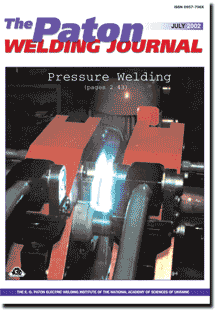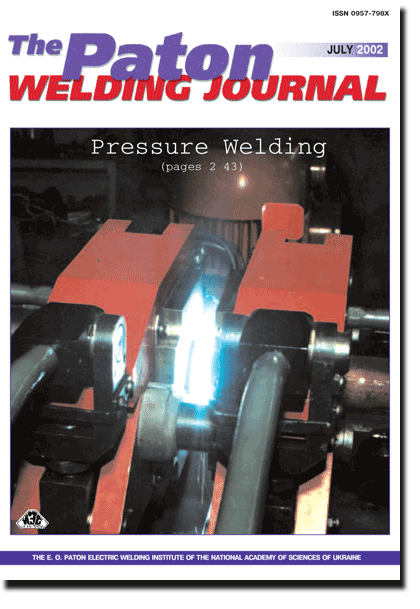

| PRESSURE WELDING | |
| Kuchuk-Yatsenko S.I. and Zyakhor I.V. Mechanism of bimetal joints formation in friction welding. | 2 |
| Features have been studied of contact interaction of copper and steel 12Kh18N10T with AD1 aluminium alloy in friction welding. Regularities of friction surface displacement in time and dependence of the displacement magnitude on process parameters have been established. Influence was studied of the initial and final stages of the welding process on the processes of mass transfer in the butt and kinetics of early stages of formation of the intermetallic interlayer in welding of copper to aluminium. A new process of friction welding with controlled deceleration of rotation has been developed. | |
| Tretyak N.G. Friction stir welding of aluminium alloys (Review). | 10 |
| Considered are main principles of realisation of a new method for friction stir welding (FSW), allowing production of various joints in sheet billets. Designs of the tools for realisation of FSW, peculiarities of formation of the joints in different aluminium alloys, their properties and structure, application fields, equipment for FSW of various structures, quality control methods and methods for elimination of specific defects are described. | |
| Pismenny A.S. and Prokofiev A.S. Press welding of pipes using activating materials. | 19 |
| Considered are capabilities of new technologies involving activating materials for induction butt welding of small- and medium-diameter pipes, producing of T-joints in thin-walled pipes and joining of pipes to flanges (braze welding). Data on service properties of welded joints and results of laboratory and industrial tests of specimens and pipes produced by the above technologies using induction heating are reviewed. | |
| Kuchuk-Yatsenko S.I., Kachinsky V.S. and Ignatenko V.Yu. Magnetically-impelled arc butt welding of thick-walled pipes. | 24 |
| The new method of a magnetically-impelled arc butt (MIAB) welding of pipes with a wall thickness exceeding the sizes of active spots of arc column, has been developed. Results of MIAB welding of low-alloyed steel pipes with up to 16 | |
| Kireev L.S. and Zamkov V.N. Solid-state joining of titanium to steel (Review). | 29 |
| Considered are the methods for solid-state joining of titanium to steel with a different degree of the force effect: diffusion bonding, cold welding, inertia friction welding, wedge-press and vacuum press welding, explosion welding, vacuum percussion welding and magnetic-pulse welding. The ways of producing quality joints are described. | |
| Kharchenko G.K., Falchenko Yu.V., Novomlinets O.A. and Gorban V.F. Vacuum diffusion bonding of chromium to copper. | 36 |
| The technology for vacuum diffusion bonding (VDB) of chromium to copper has been developed to manufacture bimetal cathodes used for making wear-resistant friction layers and decorative coatings. It has been established that VDB results in deposition of copper on chromium in the contact zone. The mechanism of deformation of the perforated copper interlayer has been studied. The use of such an interlayer is shown to hold promise for VDB of chromium to copper. | |
| Markashova L.I., Arsenyuk V.V., Grigorenko G.M. and Berdnikova E.N. Mass transfer processes in pressure joining of dissimilar metals. | 38 |
| Considered are the principles of basic physical-chemical processes (plastic deformation, mass transfer, phase formation) accompanying formation of joints in dissimilar materials (copper, titanium, aluminium and their alloys, as well as different grades of steels) characterised by a limited mutual solubility under pressure joining conditions for a wide range of external loading rates (1x10-4 -1x105 s-1). | |
| INDUSTRIAL | |
| Korotynsky A.E. State-of-the-art, tendencies and prospects of development of high-frequency welding converters (Review). | 44 |
| Main stages of evolution of high-frequency welding converters based on power transistor switches are considered. It is shown that main success in the development of welding equipment of this type is mainly due to achievements in the field of power electronics. New types of power modules based on distribution of structures and cycloconverter circuits are described. The ways for further improvement and development of welding power sources are outlined. | |
(You are viewing the simplified file contents)
The cost of subscription/purchase order journals or individual articles
| Journal/Currency | Annual Set | 1 issue printed |
1 issue |
one article |
| TPWJ/USD | 384 $ | 32 $ | 26 $ | 13 $ |
| TPWJ/EUR | 348 € | 29 € | 24 € | 12 € |
| TPWJ/UAH | 7200 UAH | 600 UAH | 600 UAH | 280 UAH |
| AS/UAH | 1800 UAH | 300 UAH | 300 UAH | 150 UAH |
| AS/USD | 192 $ | 32 $ | 26 $ | 13 $ |
| AS/EUR | 180 € | 30 € | 25 € | 12 € |
| SEM/UAH | 1200 UAH | 300 UAH | 300 UAH | 150 UAH |
| SEM/USD | 128 $ | 32 $ | 26 $ | 13 $ |
| SEM/EUR | 120 € | 30 € | 25 € | 12 € |
| TDNK/UAH | 1200 UAH | 300 UAH | 300 UAH | 150 UAH |
| TDNK/USD | 128 $ | 32 $ | 26 $ | 13 $ |
| TDNK/EUR | 120 € | 30 € | 25 € | 15 € |
AS = «Automatic Welding» - 6 issues per year;
TPWJ = «PATON WELDING JOURNAL» - 12 issues per year;
SEM = «Electrometallurgy Today» - 4 issues per year;
TDNK = «Technical Diagnostics and Non-Destructive Testing» - 4 issues per year.


